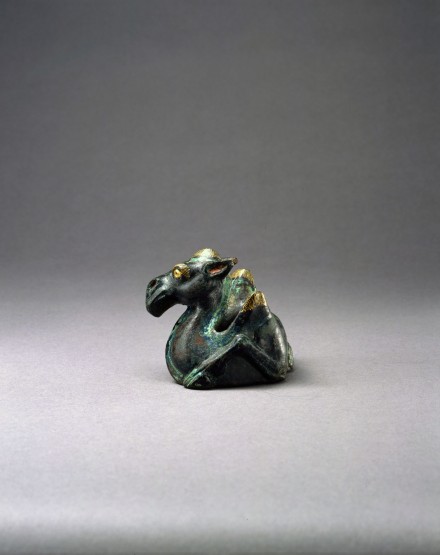J.J. Lally & Co., Oriental Art / New York City, New York
MenuPast Exhibition
Bronze and Gold in Ancient China
March 24 - April 12, 2003

20.
A GOLD- INLAID BRONZE CAMEL-FORM WEIGHT
Western Han Dynasty, 2nd-1st century B.C.
heavily cast and superbly modelled, the animal shown in a lively recumbent pose with body sharply turned and head held up at a dramatic angle, the legs tucked under and held in close to the smooth flanks, with details very finely inlaid in gold including stylized linear hair markings on the tops of the twin humps, on the crest of the head, and on the thick ridged eyebrows above large eyes inlaid in gold foil, the very dark surface of the bronze showing traces of cuprite red and azurite blue patina, with wider areas of malachite green remaining in a thin crust, the recessed interior of the ears and nostrils retaining original cinnabar red pigment, the underside filled with iron and lead amalgam to serve as a weight.
Length 3 inches (7.6 cm)
Bronze weights in the form of compactly modelled animals are a well-known feature of the repertoire of the Han sculptor. Many examples in the form of coiled tigers, bears, rams, deer, phoenixes and dragons have been published, but no other Han bronze weight in the form of a recumbent camel appears to have been previously recorded.
For a discussion of different types of Han weights and their functions, see Sun Ji, 'Han zhen yishu' (Notes on the Arts and Crafts of Han Dynasty Weights), Wenwu, 1983, No. 6, pp. 69
20.
A GOLD- INLAID BRONZE CAMEL-FORM WEIGHT
Western Han Dynasty, 2nd-1st century B.C.
Length 3 inches (7.6 cm)